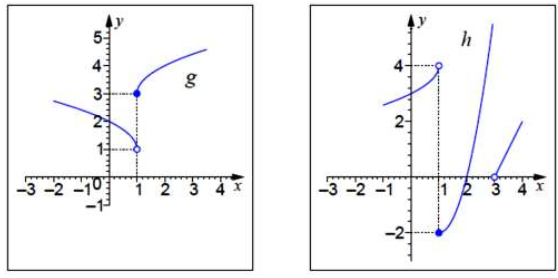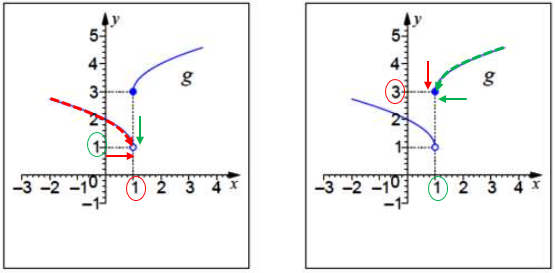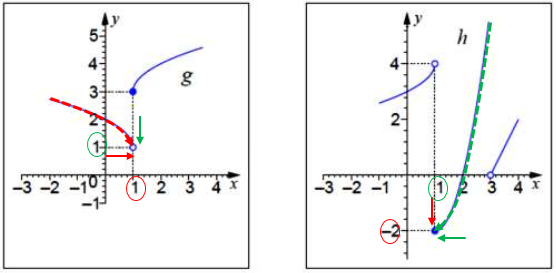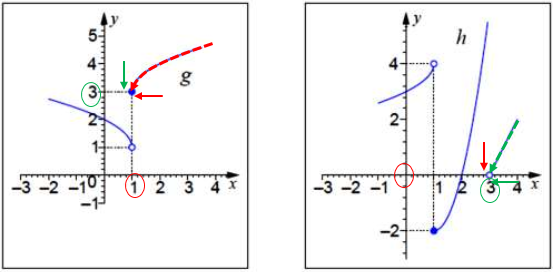How To Find Limits Of Composite Functions
(A new question of the week)
A skillful way to develop a sense of what limits are and how they work comes from working with visual representations of them, in the form of graphs. In particular when the functions are defined by graphs rather than past equations, nosotros accept a lot more flexibility in creating a problem, and can produce special cases that would otherwise be hard to create. Today's question, from late February, is about a relatively obscure example, namely i-sided limits of a composite function.
Limits of a composite role
Here is the question, from Drey:
Given the following graphs of g and h, discover the right side limit and left side limit of f(ten) = (h o g)(x) in ten = one.

Provided solution:
lim ten–>1 – f(x) = -ii
lim x–>one + f(x) = 0
What I did:
f(x)=(h o thousand)(10) significant f(x)=yard(x)*h(ten)
Analyzing the graph I tin can see that lim ten–>one one thousand(10) = i and lim 10–>1 h(x) = four. Could yous give me tips on what should I practice side by side?
The problem asks for the left-hand and right-hand limits of the composite function \(f=h\circ g\) at \(x=1\). Drey has correctly read the (left-paw) limits of g and h at 1 as one and 4; but he has misread the problem as to what f means, so the latter is irrelevant.
Drey had previously asked about some very different problems that involved limits of composite functions, for which Doctor Rick had provided a link to
Limit of Composite Part
The theorem stated at that place says,
Let \(f\) and \(g\) exist real functions.
Let:
\(\displaystyle\lim_{y→\eta}f(y) = l\)
\(\displaystyle\lim_{x→\eleven}thou(x) = \eta\)Then, if either:
Hypothesis 1: \(f\) is continuous at η (that is \(l = f(\eta)\))
or:
Hypothesis 2: for some open interval I containing ξ, information technology is true that \(m(10) ≠ \eta\) for whatsoever \(x\in I\) except possibly \(x = \11\)
and so:
\(\displaystyle\lim_{x→\xi}f(g(10)) = \lim_{y→\eta}f(y)\)
That is, if either the outer function f is continuous at the relevant bespeak, or the inner function is not-constant about the relevant betoken, the limit of the composite function is just the limit of the outer office evaluated at the limit of the inner function. Nosotros can safely merely substitute: $$\lim_{x→a}f(g(x)) = \lim_{y→\lim_{x→a}g(10)}f(y)$$ (The link demonstrates the need for at least one of the hypotheses to exist true. The 2nd is true for our problem.)
Doc Rick answered:
Hi, Drey.
Are this and your previous pair of limit problems from a course? There is a connection between them, in that I related those problems to a theorem virtually limits of compositions of functions, and this trouble also deals with limits and composition.
The difference is that the functions in this problem do not have (two-sided) limits at the relevant points, merely just one-sided limits. It is not a large leap to see how the aforementioned idea can exist used with 1-sided limits; but we demand to recall carefully virtually which "side" of each limit we use.
We will be extending the previously stated theorem (or the idea that it embodies) to one-sided limits.
What is a blended function?
Before nosotros can become at that place, however, it appears that you are confused virtually what a composition of functionsis. You say
f(ten) = (h o g)(x) meaning f(ten) = m(x)*h(x)
only this is what theproduct office (hg) is, non thecomposition h ∘ g. The composition of h and g is defined equally
(h ∘ g)(x) = h(g(x))
for all x in the domain of one thousand such that thou(x) is in the domain of h.
As well you say that from the graph you observe
lim 10–>1 g(10)=ane and lim ten–>one h(x)=4
Did yous really mean this? What I see is that for one thousand, for instance,
lim10–>1 – thou(x) = 1
limx–>ane + g(ten) = 3
Perhaps y'all meant to put in minus signs on both of your limits.
Drey found limits (actually one-sided) of both functions at \(x=i\), which would have been appropriate for the product function \(hg\), in which both are evaluated for the same input; for the composite function \(h\circ m\), we'll be evaluating the limit of 1 at the limit of the other, rather than at the same place.
A different example
Nosotros often demonstrate how to solve a problem by solving a similar i, to leave the "patient" gear up to do their ain.
Now, in club to help you understand how to solve your trouble, I'm going to solve adissimilar trouble with the same functions. Let'south find
limx–>1 – (g ∘ m)(x)
As I mentioned, this ways
limx–>i – 1000(g(x))
Looking at the "inside" function g, as 10 approaches 1from the left, g(x) approaches onefrom higher up — k(10) is greater than one to start with, and decreasing toward 1. And this g(x) is the argument of the "outside" function thou, which therefore approaches 1from the correct.
Therefore, letting u = g(x), what we want is
lim10–>1 – chiliad(m(ten)) = limu–>1 + g(u) = 3
Does that make sense? Give your trouble a try based on this idea, and testify me your work. Then I volition see whether you are getting the idea, and if non, I might see what you are missing, and so I can explicate that office more carefully.
Here is a flick of what he did (notice that, because one thousand is being used twice hither, I am using two copies of the graph of m):

On the left, looking at the inner function g, the ruby-red arrow shows how x is approaching 1 from the left; following the broken red bend, we see that y decreases to ane (the light-green arrow).
On the correct, we run into what is happening in the outer function g. At that place, the dark-green arrow shows 10 (which was the y for the inner part) decreasing to one, and following the broken green bend, we see y decreasing to iii (the red pointer). And then the limit is 3.
That is, every bit x approaches ane from the left, \(one thousand(10)\) approaches 1 from the right, and therefore \(chiliad(m(x))\) approaches iii from the correct (from to a higher place).
The original problem solved
Drey responded,
Hello Doc Rick.
Yes, this and the previous pair of limits are part of a class.
I gave the problem a try and I managed to understand how to find
lim10–>one – k(x) = ane
limten–>1 + g(10) = 3
In order to detect f(10) I did f(x) = lim10–>ane – f(u) where u = one from limx–>i – one thousand(x) = 1
Well I don't know how to explain it but the only value that goes to i in the 10 centrality and seems to be decreasing is -ii then
limx–>one – f(u) = -2
at present for lim10–>1 + f(u) where u =three from lim10–>i + g(x) = 3 so f(3) seem to be increasing equally 10 approaches 3 so the issue is 3.
That's what I got.
He has the right limits for the outer function in his problem, g. Then he actually gets the right answers, but appears to be guessing. We need to remove the guessing!
The answer explained in item
Doctor Rick answered,
Hi, Drey. You said:
In order to discover f(x) I did f(x) = limx–>i – f(u) where u = one from
limx–>i – yard(x) = aneWell I don't know how to explain it but the only value that goes to 1 in the ten axis and seems to be decreasing is -2 so limx–>i – f(u) = -2
Yous got the right answer, but I cannot follow your caption. I know, youssaid you don't know how to explain it — and it is indeed difficult to talk about.
Let's assume he had the right ideas, but needs assistance proverb them. What are the parts of his explanation that don't work?
Starting time, f(x) is not a limit; it is merely f(x) = (h ∘ g)(10). What you meant in the offset line above is that you're trying to find the left-hand limit of f(x) as x approaches ane.
When you lot so put f(u) in the limit expression, I don't call up f belongs there — information technology ought to be h. Then y'all say, "where u=1"; that doesn't make sense as it stands: we can't put a stock-still number at that place — something has to be varying. Likewise, nosotros can't say that -2 is a "value that goes to ane …"; -2 doesn't get anywhere!
We need to carefully distinguish limits from actual function values, and variables from specific numerical values. In part, this is why the terminology of limits was invented: to get in possible to talk about what the ideas of calculus hateful!
Innovate suitable notation
So, how can we talk most this in a mode that makes sense? Let'south endeavour to notice a way – we might be inventing some notation forth the style.
We are evaluating
lim10–>1 – h(g(x))
I don't know if you're being taught the limit theorem I showed you for the previous problems as a formal theorem or more intuitively, but the conclusion of that theorem said (using our function names) that
If limy–>η h(y) = L and limx–>ξ g(x) = η, then
limx–>ξ h(g(x)) = limy–>η h(y)
This theorem needs to be modified to deal with one-sided limits, by because from which side each limit above is taken. Nosotros know that we want to observe theleft-hand limit of h(thousand(x)) equally x approaches 1, so the ξ above should be replaced by 1–, and we start by finding (simply as in my example)
lim10–>i – grand(x) = 1
Only nosotros need to knowfrom which side g(10) approaches one. As I noted in the case, every bit x comes in toward i from the left, thousand(x) comes down toward 1 from above. So let's invent a notation as a way to say that:
limx–>i – k(x) = 1+
We unremarkably use the superscript sign merely in stating what the input approaches (and from what direction). Simply this seems like a reasonable notation, every bit long as we continue in listen that "ane+" is not an actual number, just a description of a movement. It is what we will be writing in the limit statement to follow.
It is not uncommon that inventing a notation is a useful stride in problem-solving. In George Pólya's famous book How to Solve It, one piece of advice nether the outset pace, Empathize the Problem, is "Introduce suitable annotation." Doing so helps us to communicate with ourselves nigh the trouble, and afterward to others. The same is true of a picture show or other graphic representation of the problem.
If we were writing a formal proof, we would probably make a precise definition of this notation; but in informal thinking, we but need to be certain we know what it means. Equally we'll come across, it is really a visual concept as we apply it to the graph.
The left-hand limit
Now we know that the limit of h that we need is as y = g(x) approaches 1from the right (1+):
limy–>ane + h(y) = ?
Looking at the graph of h(ten), nosotros see that as x (the statement of h as shown on the graph) approaches i from the right, the bend comes downwards to the limiting value of -ii. Thus,
limy–>1 + h(y) = -2
and we have
limx–>ane – (h ∘ g)(x) = limy–>1 + h(y) = -ii
That's the reply you lot got!
Here is a motion picture of what we've washed here, like the pic above (this time including the two different functions):

As earlier, on the left, looking at the inner office g, the red arrow shows how x is approaching 1 from the left; post-obit the broken scarlet curve, nosotros see that y decreases to 1 (the green arrow).
On the correct, we encounter what is happening in the outer office h. There, the green arrow shows x (which was the y for the inner office) decreasing to 1, and post-obit the broken green curve, we run into y decreasing to -2 (the ruddy arrow). So the limit is -ii.
That is, as x approaches 1 from the left, \(g(10)\) approaches 1 from the right, and therefore \(h(yard(10))\) approaches -ii from the right (from above).
The right-hand limit
now for limx–>ane + f(u) where u =3 from limx–>1 + g(x) = iii so f(3) seem to be increasing equally ten approaches 3 so the result is 3.
Again, it doesn't make sense to say that f(three) increases – f(three) is only a fixed number. But using my annotation, we want to find
limx–>one + h(g(x))
so we offset find
lim10–>1 + k(10) = 3+
(because, on the graph of g(10), equally x comes in toward 1 from the right, the curve comesdown toward 3). Thus the concluding stride is
limy–>three + h(y) = 0
which isnot what you got. Perhaps y'all didn't meet that m(x) approaches 3 from above, so that the y to a higher place approaches 3 from the right. If you thought that y approached 3 from the left, and so you also didn't notice that on the graph of h(ten), h(y) increases toward some unspecified limit (maybe infinity?) as x approaches 3 from the left.
These are tricky. I promise you have some other trouble like this that you lot can show me, with your work, so we tin meet if y'all have gotten the idea nonetheless.
Again, here is a film:

On the left, the scarlet pointer shows how x is approaching 1 from the right; following the broken carmine curve, we come across that y decreases to three (the green arrow).
On the right, nosotros encounter what is happening in the outer function h. In that location, the green arrow shows ten (which was the y for the inner function) decreasing to 3, and post-obit the cleaved green line, we see y decreasing to 0 (the red arrow). And so the limit is 0.
That is, as x approaches one from the right, \(g(x)\) approaches 3 from the correct, and therefore \(h(g(x))\) approaches 0 from the right (from above).
We now have both a written notation and a visual process for solving these. Drey didn't reply once more (to this thread), so we trust that it worked.
Source: https://www.themathdoctors.org/one-sided-limits-of-a-composite-function/
Posted by: fullerondowde.blogspot.com


0 Response to "How To Find Limits Of Composite Functions"
Post a Comment